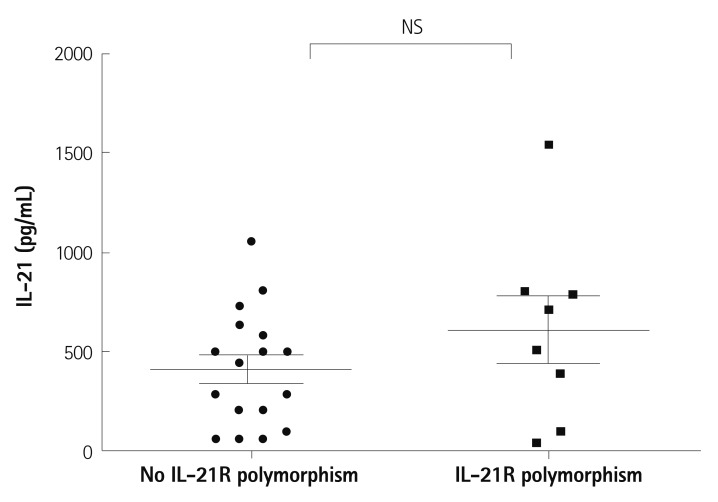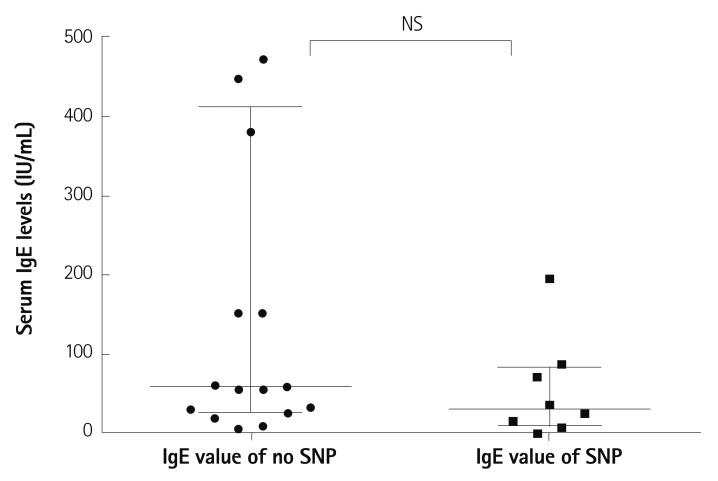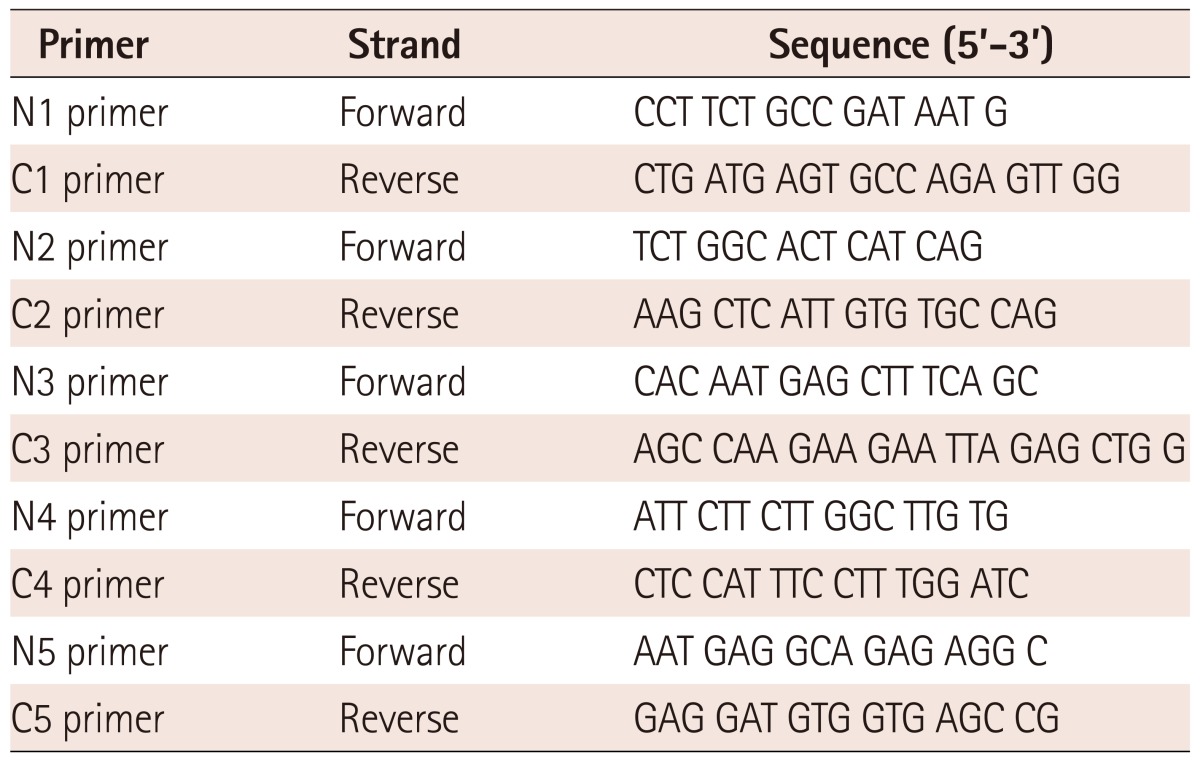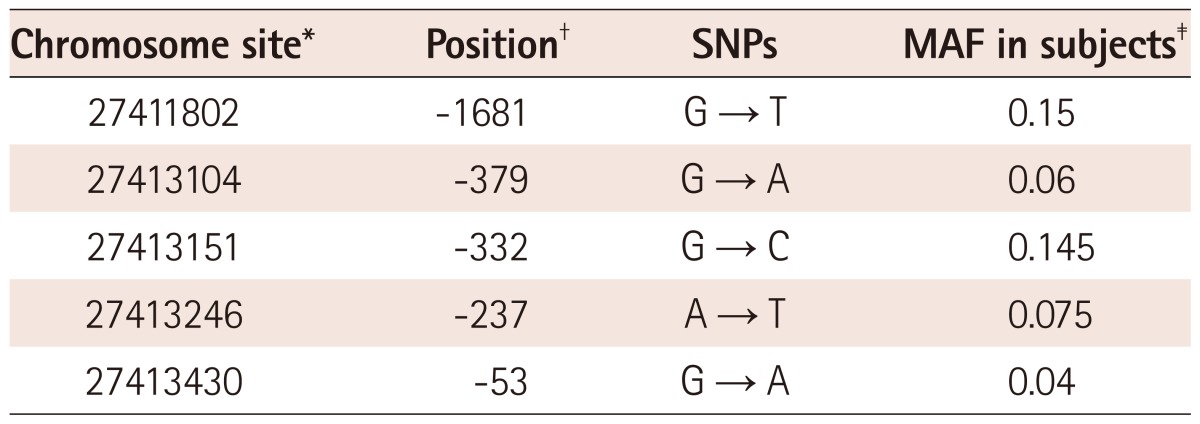1. Kawasaki T. [Acute febrile mucocutaneous syndrome with lymphoid involvement with specific desquamation of the fingers and toes in children]. Arerugi. 1967; 16:178–222. PMID:
6062087.
2. Onouchi Y. Molecular genetics of Kawasaki disease. Pediatr Res. 2009; 65:46R–54R.
3. Burns JC, Glodé MP. Kawasaki syndrome. Lancet. 2004; 364:533–544. PMID:
15302199.
4. Cheung YF, Huang GY, Chen SB, et al. Inflammatory gene polymorphisms and susceptibility to kawasaki disease and its arterial sequelae. Pediatrics. 2008; 122:e608–e614. PMID:
18710885.
5. Yeung RS. Kawasaki disease: update on pathogenesis. Curr Opin Rheumatol. 2010; 22:551–560. PMID:
20616737.
6. Sohn MH, Hur MW, Kim DS. Interleukin 6 gene promoter polymorphism is not associated with Kawasaki disease. Genes Immun. 2001; 2:357–362. PMID:
11704800.
7. Ahn HM, Park IS, Hong SJ, Hong YM. Interleukin-6 (-636 c/g) gene polymorphism in Korean children with Kawasaki disease. Korean Circ J. 2011; 41:321–326. PMID:
21779285.
8. Quasney MW, Bronstein DE, Cantor RM, et al. Increased frequency of alleles associated with elevated tumor necrosis factor-alpha levels in children with Kawasaki disease. Pediatr Res. 2001; 49:686–690. PMID:
11328953.
9. Huang FY, Chang TY, Chen MR, et al. Genetic polymorphisms in the CD40 ligand gene and Kawasaki disease. J Clin Immunol. 2008; 28:405–410. PMID:
18481160.
10. Breunis WB, Biezeveld MH, Geissler J, et al. Polymorphisms in chemokine receptor genes and susceptibility to Kawasaki disease. Clin Exp Immunol. 2007; 150:83–90. PMID:
17672867.
11. Chun JK, Kang DW, Yoo BW, Shin JS, Kim DS. Programmed death-1 (PD-1) gene polymorphisms lodged in the genetic predispositions of Kawasaki Disease. Eur J Pediatr. 2010; 169:181–185. PMID:
19468750.
12. Furuno K, Yuge T, Kusuhara K, et al. CD25+CD4+ regulatory T cells in patients with Kawasaki disease. J Pediatr. 2004; 145:385–390. PMID:
15343196.
13. Sohn SY, Song YW, Yeo YK, et al. Alteration of CD4CD25Foxp3 T cell level in Kawasaki disease. Korean J Pediatr. 2011; 54:157–162. PMID:
21738549.
14. Franco A, Shimizu C, Tremoulet AH, Burns JC. Memory T-cells and characterization of peripheral T-cell clones in acute Kawasaki disease. Autoimmunity. 2010; 43:317–324. PMID:
20166878.
15. Gómez-Martín D, Díaz-Zamudio M, Romo-Tena J, Ibarra-Sánchez MJ, Alcocer-Varela J. Follicular helper T cells poise immune responses to the development of autoimmune pathology. Autoimmun Rev. 2011; 10:325–330. PMID:
21167320.
16. King C, Ilic A, Koelsch K, Sarvetnick N. Homeostatic expansion of T cells during immune insufficiency generates autoimmunity. Cell. 2004; 117:265–277. PMID:
15084263.
17. Jin H, Carrio R, Yu A, Malek TR. Distinct activation signals determine whether IL-21 induces B cell costimulation, growth arrest, or Bim-dependent apoptosis. J Immunol. 2004; 173:657–665. PMID:
15210829.
18. Lee HK, Kim DS, Noh GW, Lee KY. Effects of intravenous immune globulin on the peripheral lymphocyte phenotypes in Kawasaki disease. Yonsei Med J. 1996; 37:357–363. PMID:
8997168.
19. Ozaki K, Kikly K, Michalovich D, Young PR, Leonard WJ. Cloning of a type I cytokine receptor most related to the IL-2 receptor beta chain. Proc Natl Acad Sci U S A. 2000; 97:11439–11444. PMID:
11016959.
20. Bae YJ, Kim MH, Lee HY, et al. Elevated Serum Levels of IL-21 in Kawasaki Disease. Allergy Asthma Immunol Res. 2012; 4:351–356. PMID:
23115732.
21. Newburger JW, Takahashi M, Gerber MA, et al. Diagnosis, treatment, and long-term management of Kawasaki disease: a statement for health professionals from the Committee on Rheumatic Fever, Endocarditis and Kawasaki Disease, Council on Cardiovascular Disease in the Young, American Heart Association. Circulation. 2004; 110:2747–2771. PMID:
15505111.
22. Pène J, Guglielmi L, Gauchat JF, et al. IFN-gamma-mediated inhibition of human IgE synthesis by IL-21 is associated with a polymorphism in the IL-21R gene. J Immunol. 2006; 177:5006–5013. PMID:
17015683.
23. Caprioli F, Sarra M, Caruso R, et al. Autocrine regulation of IL-21 production in human T lymphocytes. J Immunol. 2008; 180:1800–1807. PMID:
18209077.
24. Cannons JL, Qi H, Lu KT, et al. Optimal germinal center responses require a multistage T cell:B cell adhesion process involving integrins, SLAM-associated protein, and CD84. Immunity. 2010; 32:253–265. PMID:
20153220.
25. Bennett F, Luxenberg D, Ling V, et al. Program death-1 engagement upon TCR activation has distinct effects on costimulation and cytokine-driven proliferation: attenuation of ICOS, IL-4, and IL-21, but not CD28, IL-7, and IL-15 responses. J Immunol. 2003; 170:711–718. PMID:
12517932.
26. Cui W, Liu Y, Weinstein JS, Craft J, Kaech SM. An interleukin-21-interleukin-10-STAT3 pathway is critical for functional maturation of memory CD8+ T cells. Immunity. 2011; 35:792–805. PMID:
22118527.
27. Linterman MA, Vinuesa CG. Signals that influence T follicular helper cell differentiation and function. Semin Immunopathol. 2010; 32:183–196. PMID:
20107805.
28. Nara H, Onoda T, Rahman M, et al. Regulation of interleukin-21 receptor expression and its signal transduction by WSB-2. Biochem Biophys Res Commun. 2010; 392:171–177. PMID:
20059963.
29. Hecker M, Bohnert A, König IR, Bein G, Hackstein H. Novel genetic variation of human interleukin-21 receptor is associated with elevated IgE levels in females. Genes Immun. 2003; 4:228–233. PMID:
12700598.
30. Bucher C, Koch L, Vogtenhuber C, et al. IL-21 blockade reduces graft-versus-host disease mortality by supporting inducible T regulatory cell generation. Blood. 2009; 114:5375–5384. PMID:
19843883.






 PDF
PDF ePub
ePub Citation
Citation Print
Print







 XML Download
XML Download